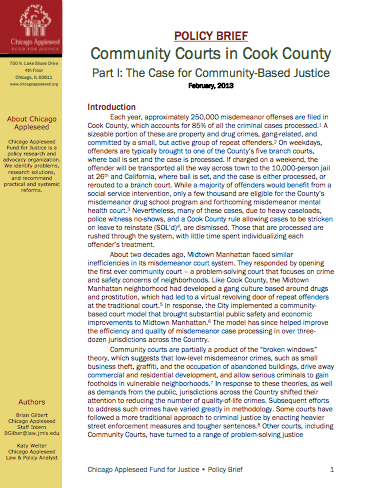Policy Brief: Community Courts in Cook County
Today we release a two-part policy brief discussing an alternative prosecution strategy called community-based justice. Part I makes the case for community-base justice by comparing Cook County’s current misdemeanor justice system–which adjudicates over 150,000 misdemeanors annually (pdf)–with community justice systems in Minnesota and New York. Part II shares strategies for Cook County to expand its own efforts at such a system.
Community courts are strategically placed in or near neighborhoods with high rates of crime. They typically contain a dedicated judge, prosecutor, and courtroom staff, and often times a dedicated public defender, police team, and group of local community service agencies. With the courtroom closer to the crime, offenders can receive more face-time with the judge and their attorney, and swift access to a variety of nearby community services.
Brian Gilbert, a Chicago Appleseed intern and John Marshall Law School student, conducted on-the-ground research while developing the brief. He interviewed community prosecutors in Cook County and Hennepin County (Minneapolis, MN) and also considered peer-reviewed research.
Brian found that by minimizing jail time and transportation needs, community courts are able to cost-effectively devote more time to more cases, while also accounting for the social idiosyncrasies of different neighborhoods within the city. Moreover, research has shown that community courts can improve compliance rates by around 25% while maintaining recidivism rates equal to or less than the traditional criminal justice system.
Community courts can shorten the time from arrest to arraignment to as little as 19 hours, meaning graffiti taggers can be sentenced to community service–i.e. removing their own graffiti–within 24 hours of offending.
Ask yourself: would you rather a graffiti offender sit in jail on the public’s dime the day after arrest–or scrub paint off the wall he defaced?
You can find the briefs on our Criminal Justice page.

